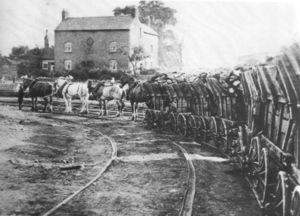Little Eaton Gangway
| Little Eaton Gangway | |
|---|---|
| Locale | England |
| Dates of operation | 1795 – 1905 |
| Track gauge | 3 ft 6 in (1067 mm) and 4 ft (1219 mm) |
| Length | 5 miles |
| Headquarters | Little Eaton |
The Little Eaton Gangway, or, to give it its official title, the Derby Canal Railway, was a narrow gauge industrial plateway serving the Derby Canal at Little Eaton in Derbyshire.
The Derby Canal
In 1792, Benjamin Outram was asked to prepare plans for a broad canal from Swarkestone to Smithy Houses, near Denby, with a branch at Derby to the Erewash Canal at Sandiacre, which he estimated would cost £60,000. The use of a tramway as an alternative was first proposed by William Jessop on 3 November 1792. The Derby Canal Act of 1793 authorized a rail connection between the Derby Canal at Little Eaton and the collieries to the north. The tramway ran four miles from the canal wharf to Smithy Houses and another mile further to Denby Hall Colliery. Further short branches served Salterwood North and Henmoor Collieries as well as the Denby Pottery.
The The purpose of this 5-mile long tramway was to carry coal from Kilburn and Denby down to the canal at Little Eaton and general goods inclusing stone, pottery and "clogs of wood".
Construction
Outram's original plan was for a conventional waggonway with wooden sleepers and oak rails reinforced with cast iron plates. Accordingly, an advertisement appeared in the Lincoln & Stamford Mercury for 16 August 1793 for oak sleepers 4 feet 6 inches long squared at each end for a length of 9 inches.
However by the time the railway was approved, Outram had decided to use the flanged rails with which his name has become associated. In this he may have been influenced by Jessop, whose father had worked for Thomas Telford on the construction of the Eddystone Lighthouse, also by Joseph Butler of Wingerworth near Chesterfield, who had constructed a similar line in 1788. Butler is believed to have been the first to do so, and supplied the rails, rather than Outram's own works. Both Outram and Jessop preferred stone blocks to sleepers. These were drilled with a six inch hole into which an oak plug was fitted. The rails, approximately three feet long, were attached by means of spikes. The line was originally 3 ft 6 in (1067 mm) gauge, being increased later to 4 ft (1219 mm) at an unknown date.
The waggons, built at Outram's Butterley works consisted of containers mounted loosely on a chassis, or tram, with four cast iron wheels. The container would be lifted off at Little Eaton and loaded complete into narrowboats or transferred to two-wheeled carts for carriage by road. The canal line from Little Eaton led to Gandy's Wharf in Derby for onward distribution through the canal network or by road. Probably the first instance of containerisation in the world.
The gangway and the Little Eaton line of the canal opened in 1795, the first load of coal from Denby being distributed to the poor of Derby.
Decline
When the Midland Railway built its branch line to Ripley in 1856, it lost most of its trade, finally closing in 1908.
The trackbed was used for a new road, the A61, bypassing the old road through Coxbench. This, in turn, was superseded at the end of the twentieth century by the A38 trunk road, demoting it to the B6179. Thus there are three generations of highway side-by-side, plus the remains of the railway.
The only remaining trace is the Wharf building seen in the photo above, the easternmost arch of Jack O' Darley bridge, and another two arch bridge over the Bottle Brook, with a few of the sleeper stones that have been used in nearby walls. A wagon from this period of the gangway's history survives in the National Mining Museum at Lound Hall.
References
- Schofield, R.B. (2000). Benjamin Outram. Cardiff: Merton Priory Press.
- Ripley, D. (1993). The Little Eaton Gangway and Derby Canal. The Oakwood Press.
- Leleux, Sydney A. (June 1969). "Little Eaton Tramroad". Industrial Railway Record 25: 90-93.

